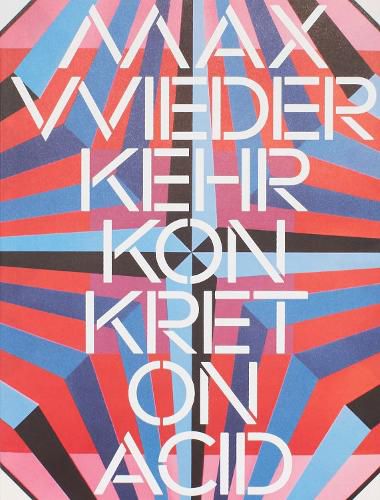Readings Newsletter
Become a Readings Member to make your shopping experience even easier.
Sign in or sign up for free!
You’re not far away from qualifying for FREE standard shipping within Australia
You’ve qualified for FREE standard shipping within Australia
The cart is loading…






Max Wiederkehr's visual idiom was always influenced by Zuerich's concrete art, though interspersed with Pop and op art elements. After his initial breakthrough, he turned his back on the established art world and embraced the nascent subculture instead. He drew comics, painted, occasionally exhibited, and went on to make pieces that were still geometrically influenced or inflected, but went beyond geometry to develop a fascinating interplay of calculation and intuition and a surprising blend of highbrow and low. Although it was actually considered unthinkable at the time, he was working away at the interface between two Zurich schools, the fantastical (with its so-called Wahnwelten or "hallucinatory worlds") and the concrete, and forging a unique amalgamation of the two.
It is amusing and refreshing to compare Bill, Loewensberg and Honegger, who'd have been appalled to be called "outsiders", to Wiederkehr, who was close to the outsiders, to the neatly dressed painters of Huesli-Eggli (lit. "houses and corners", i.e. metonymically "boxes and angles"), as Friedrich Kuhn called them, on the one hand, and the radical left-wing Stadtindianer (the Teutonic counterpart to Italy's Indiani Metropolitani) on the other. Recent access to Wiederkehr's estate has now brought to light the overall oeuvre of an artist who stood outside the cultural establishment, but whose offside position was by no means outsider art: Wiederkehr was thoroughly versed in modernity, which he turned inside out and outside in.
$9.00 standard shipping within Australia
FREE standard shipping within Australia for orders over $100.00
Express & International shipping calculated at checkout
Max Wiederkehr's visual idiom was always influenced by Zuerich's concrete art, though interspersed with Pop and op art elements. After his initial breakthrough, he turned his back on the established art world and embraced the nascent subculture instead. He drew comics, painted, occasionally exhibited, and went on to make pieces that were still geometrically influenced or inflected, but went beyond geometry to develop a fascinating interplay of calculation and intuition and a surprising blend of highbrow and low. Although it was actually considered unthinkable at the time, he was working away at the interface between two Zurich schools, the fantastical (with its so-called Wahnwelten or "hallucinatory worlds") and the concrete, and forging a unique amalgamation of the two.
It is amusing and refreshing to compare Bill, Loewensberg and Honegger, who'd have been appalled to be called "outsiders", to Wiederkehr, who was close to the outsiders, to the neatly dressed painters of Huesli-Eggli (lit. "houses and corners", i.e. metonymically "boxes and angles"), as Friedrich Kuhn called them, on the one hand, and the radical left-wing Stadtindianer (the Teutonic counterpart to Italy's Indiani Metropolitani) on the other. Recent access to Wiederkehr's estate has now brought to light the overall oeuvre of an artist who stood outside the cultural establishment, but whose offside position was by no means outsider art: Wiederkehr was thoroughly versed in modernity, which he turned inside out and outside in.